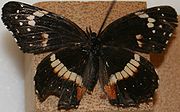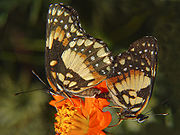
Chlosyne lacinia
Encyclopedia
The Bordered Patch is a North
and South America
n butterfly
in the family Nymphalidae
.

 The Bordered Patch is an extremely variable butterfly. The upper side of the wings is mainly black with the fore wing having rows of white and/or yellow-orange spots of varying sizes. There is usually one whitish spot in the fore wing cell. The hind wing has many color variations. Those variations can be: almost completely black to having some red postmedian spots to having a few rows of white postmedian spots to having an all red-orange discal area to having a yellow-orange postmedian band of varying width. The underside of the wings is just as variable as the upper side. It varies from having a few rows of white and red spots to having a yellow-white hind wing median band of varying width to the underside being mostly golden-yellow with large yellow-orange spots and a thick golden-yellow median band. All of these variations have a red spot near the hind wing tornus. Its wingspan ranges from 1¼ to 1⅞ inches.
The Bordered Patch is an extremely variable butterfly. The upper side of the wings is mainly black with the fore wing having rows of white and/or yellow-orange spots of varying sizes. There is usually one whitish spot in the fore wing cell. The hind wing has many color variations. Those variations can be: almost completely black to having some red postmedian spots to having a few rows of white postmedian spots to having an all red-orange discal area to having a yellow-orange postmedian band of varying width. The underside of the wings is just as variable as the upper side. It varies from having a few rows of white and red spots to having a yellow-white hind wing median band of varying width to the underside being mostly golden-yellow with large yellow-orange spots and a thick golden-yellow median band. All of these variations have a red spot near the hind wing tornus. Its wingspan ranges from 1¼ to 1⅞ inches.
).
The Crimson Patch is larger, the upper side of the fore wing has two spots in the cell, and the underside of the hind wing has a yellow basal patch with black spots in it.
The upper side of the Rosita Patch's hind wing has a basal patch which is often two toned, and the underside of the hind wing is mostly pale yellow with a thick black marginal border.
The Red-spotted Patch has a row of red marginal spots on the upper side, and underside of the hind wing.
In North America, this species prefers to inhabit agricultural areas and weedy wastelands where the preferred host plant Helianthus annuus occurs.
, late January to mid-November in Arizona
, and all year in southern Texas
.
 Males will find females by awaiting them on hilltops. Females will lay their eggs
Males will find females by awaiting them on hilltops. Females will lay their eggs
in clusters of about 100 or more on the underside of host plant leaves. The eggs are pale yellow-green but later turn a reddish color. The young larvae
feed together and but do not make a nest. They will become solitary when older. The larva is as variable as the adult. It ranges from mostly orange with black spines and stripes to black with a red-orange middorsal stripe to almost all black. All variations have a red-orange head. The chrysalis varies from almost all white to white with black markings to nearly all black. The third instar larva hibernates
and also estivates
. The Bordered Patch has 3-4 brood
s per year.
North America
North America is a continent wholly within the Northern Hemisphere and almost wholly within the Western Hemisphere. It is also considered a northern subcontinent of the Americas...
and South America
South America
South America is a continent situated in the Western Hemisphere, mostly in the Southern Hemisphere, with a relatively small portion in the Northern Hemisphere. The continent is also considered a subcontinent of the Americas. It is bordered on the west by the Pacific Ocean and on the north and east...
n butterfly
Butterfly
A butterfly is a mainly day-flying insect of the order Lepidoptera, which includes the butterflies and moths. Like other holometabolous insects, the butterfly's life cycle consists of four parts: egg, larva, pupa and adult. Most species are diurnal. Butterflies have large, often brightly coloured...
in the family Nymphalidae
Nymphalidae
The Nymphalidae is a family of about 5,000 species of butterflies which are distributed throughout most of the world. These are usually medium sized to large butterflies. Most species have a reduced pair of forelegs and many hold their colourful wings flat when resting. They are also called...
.
Description


Similar species
Similar species in the Bordered Patch's range include the Crimson Patch (Chlosyne janais), the Rosita Patch (Chlosyne rosita), and the Red-spotted Patch (Chlosyne marinaChlosyne marina
The Red-Spotted Patch or Marina Checkerspot is a butterfly of the Nymphalidae family. It is found in Mexico. Rare stray can be found as far north as southern Arizona and southern Texas....
).
The Crimson Patch is larger, the upper side of the fore wing has two spots in the cell, and the underside of the hind wing has a yellow basal patch with black spots in it.
The upper side of the Rosita Patch's hind wing has a basal patch which is often two toned, and the underside of the hind wing is mostly pale yellow with a thick black marginal border.
The Red-spotted Patch has a row of red marginal spots on the upper side, and underside of the hind wing.
Habitat
The Bordered Patch may be encountered in habitats such as desert hills, mesquite woodlands, pinyon woodlands, and oak woodlands.In North America, this species prefers to inhabit agricultural areas and weedy wastelands where the preferred host plant Helianthus annuus occurs.
Flight
This species is found from May to October in CaliforniaCalifornia
California is a state located on the West Coast of the United States. It is by far the most populous U.S. state, and the third-largest by land area...
, late January to mid-November in Arizona
Arizona
Arizona ; is a state located in the southwestern region of the United States. It is also part of the western United States and the mountain west. The capital and largest city is Phoenix...
, and all year in southern Texas
Texas
Texas is the second largest U.S. state by both area and population, and the largest state by area in the contiguous United States.The name, based on the Caddo word "Tejas" meaning "friends" or "allies", was applied by the Spanish to the Caddo themselves and to the region of their settlement in...
.
Life cycle

Egg (biology)
An egg is an organic vessel in which an embryo first begins to develop. In most birds, reptiles, insects, molluscs, fish, and monotremes, an egg is the zygote, resulting from fertilization of the ovum, which is expelled from the body and permitted to develop outside the body until the developing...
in clusters of about 100 or more on the underside of host plant leaves. The eggs are pale yellow-green but later turn a reddish color. The young larvae
Caterpillar
Caterpillars are the larval form of members of the order Lepidoptera . They are mostly herbivorous in food habit, although some species are insectivorous. Caterpillars are voracious feeders and many of them are considered to be pests in agriculture...
feed together and but do not make a nest. They will become solitary when older. The larva is as variable as the adult. It ranges from mostly orange with black spines and stripes to black with a red-orange middorsal stripe to almost all black. All variations have a red-orange head. The chrysalis varies from almost all white to white with black markings to nearly all black. The third instar larva hibernates
Hibernation
Hibernation is a state of inactivity and metabolic depression in animals, characterized by lower body temperature, slower breathing, and lower metabolic rate. Hibernating animals conserve food, especially during winter when food supplies are limited, tapping energy reserves, body fat, at a slow rate...
and also estivates
Estivation
Aestivation is a state of animal dormancy, characterized by inactivity and a lowered metabolic rate, that is entered in response to high temperatures and arid conditions...
. The Bordered Patch has 3-4 brood
Offspring
In biology, offspring is the product of reproduction, of a new organism produced by one or more parents.Collective offspring may be known as a brood or progeny in a more general way...
s per year.
Host plants
Here is a list of host plants used by the Bordered Patch:- Common Ragweed, Ambrosia artemisiifoliaAmbrosia artemisiifoliaAmbrosia artemisiifolia, Common Ragweed, is the most widespread plant of the genus Ambrosia in North America. It has also been called Annual Ragweed, Bitterweed, Blackweed, Carrot Weed, Hay Fever Weed, Roman Wormwood, Stammerwort, Stickweed, Tassel Weed, and American Wormwood...
- Giant Ragweed, Ambrosia trifidaAmbrosia trifidaCommon names: Buffalo Weed, Great Ragweed, Giant Ragweed, Bitterweed, Bloodweed, Horse Cane, Tall AmbrosiaAmbrosia trifida is an annual plant in the aster family, native throughout much of North America. Its flowers are green and are pollinated by wind rather than by insects, and the pollen is one...
var. texana - BaltimoraBaltimora (genus)Baltimora is a genus of flowering plants in the daisy family....
sp. - Straggler Daisy, Calyptocarpus vialis
- bonesets, EupatoriumEupatoriumEupatorium is a genus of flowering plants in the aster family, Asteraceae, containing from 36 to 60 species depending on the classification system. Most are herbaceous perennial plants growing to 0.5–3 m tall. A few are shrubs. The genus is native to temperate regions of the Northern Hemisphere....
sp. - Indian Blanketflower, Gaillardia pulchellaGaillardia pulchellaGaillardia pulchella , is a short-lived perennial or annual flowering plant native to the central United States.-Growth:...
- Sunflower, Helianthus annuus
- Silverleaf Sunflower, Helianthus argophyllus
- Texas Blueweed, Helianthus ciliarisHelianthus ciliarisHelianthus ciliaris is a species of sunflower known by the common names Texas blueweed and yerba parda. It is native to much of the south-central United States and northern Mexico, but it can be found elsewhere in North America where it is an introduced species and often a noxious weed...
- Cucumberleaf Sunflower, Helianthus debilis
- Maximilian Sunflower, Helianthus maximilianiHelianthus maximilianiHelianthus maximiliani is a species of sunflower known by the common name Maximilian sunflower.Native to much of the eastern half of North America, it is found in parts of the western half as an introduced species. The plant thrives in a number of ecosystems, particularly across the plains in...
- Jerusalem artichoke, Helianthus tuberosus
- Camphor Weed, Heterotheca latifolia
- Showy Palafox, Palafoxia sphacelata
- Santa Maria feverfew, Parthenium hysterophorusParthenium hysterophorusParthenium hysterophorus is a species of flowering plant in the aster family, Asteraceae, that is native to the American tropics. Common names include Santa Maria Feverfew and Whitetop Weed. It is a common invasive species in India, Australia, and parts of Africa. P. hysterophorus invades all...
- Crown-Beard, Verbesina encelioidesVerbesina encelioidesVerbesina encelioides is a flowering plant in the family Asteraceae. The species is native to the United States and Mexico. It is naturalized in the Middle East, Spain, Argentina, Australia and the Pacific islands....
- Xanthium pennsylvanicum
- Orange Zexmenia, Zexmenia hispida

